Add MoEML Locations to the Agas Map
¶Introduction to the Agas Map
Our implementation of the Agas Map is based on the OpenLayers 4.6 library and presents the map as a tiled image at
a range of different resolutions.1 Locations are plotted on the map in three
forms:
-
Polygons: closed shapes
-
MultiLineStrings: lines with multiple points
-
Points: single points
The information used to display locations is provided to the map through two JSON
files:
-
categories.json: provides information about all the location categories in our document type taxonomy -
agasLocations.json: provides information about the locations, including each location’s document type(s) and the list of referring documents
The Agas Map interface can also be used to create new shapes,
lines, and points for locations, which can be either associated with a location file
or can be used more generally to interact and draw on the map. This document will
explain
how to do both.
¶Creating a Polygon
To create a polygon shape, first zoom right into the map so that the shape you want
to
outline is taking up most of the window. In this example, we’re going to outline St. Mary Woolchurch:
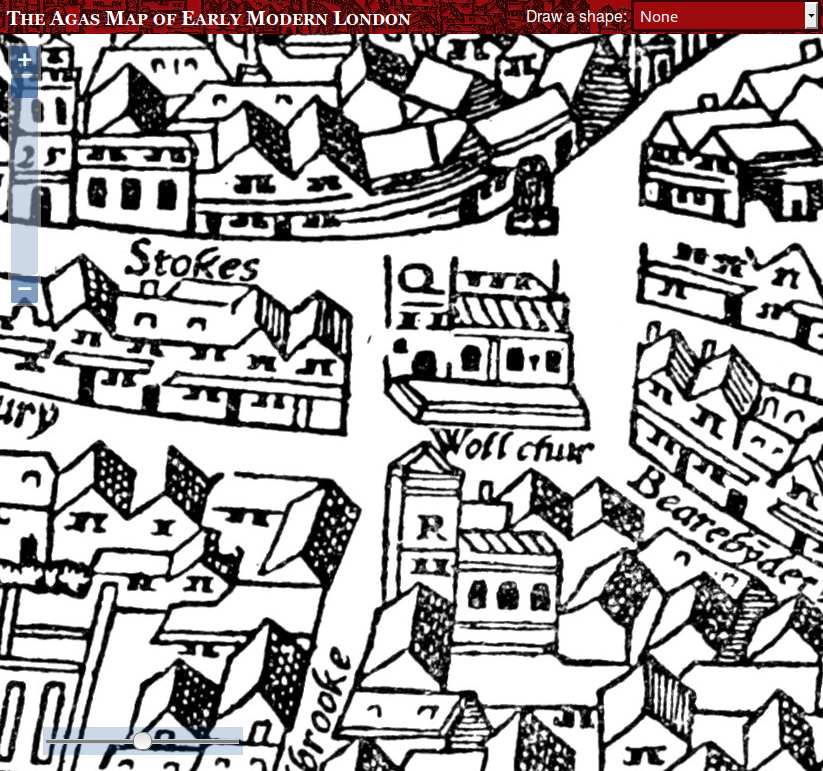
Then choose Polygon from the Draw a shape drop-down list:
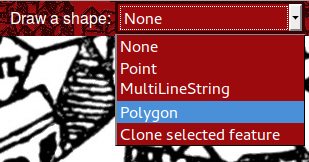
A red box appears at the bottom of the screen. We’ll see the purpose of this later.
You’ll notice that the cursor turns to a blue point. Now you can click on one of the
corners of the object to add a point. Move your mouse to the next corner, and click
there to add the next point:

Keep adding points until you have outlined the whole object:
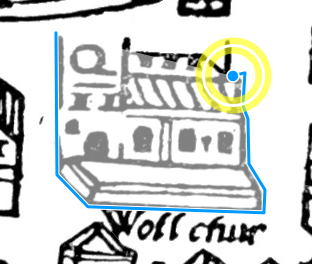
Click back on the original starting point to complete the shape.
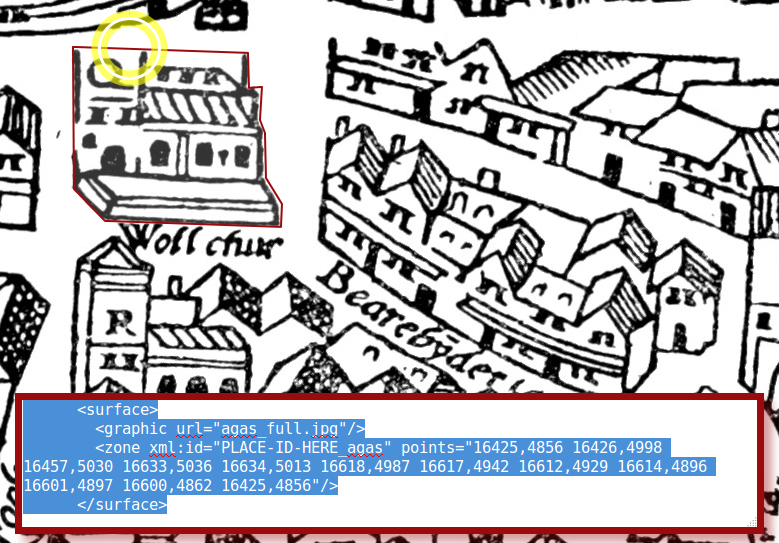
Two things will happen: the shape will change colour to show that is is complete,
and in the red box, a block of XML code will appear. This is the TEI
<surface> element that you need to add into the location file for the place. In Oxygen, open
up the appropriate location file (in this case, STMA37.xml), and locate the <facsimile> element. Note that if you are creating a new document or adding a location to an
existing document that is not already on the Agas map, it may not contain a <facsimile> element. In this case, simply add a <facsimile> element between the <teiHeader> element and the <text> element. However, you may find that there is already a <surface> element from the old Agas map images. Leave this alone, but add the new element immediately
after it:

You’ll notice that this is invalid when we first paste it in, because the location
id is wrong. Change the first part of the
@xml:id attribute on the <zone> element to match the location’s @xml:id:
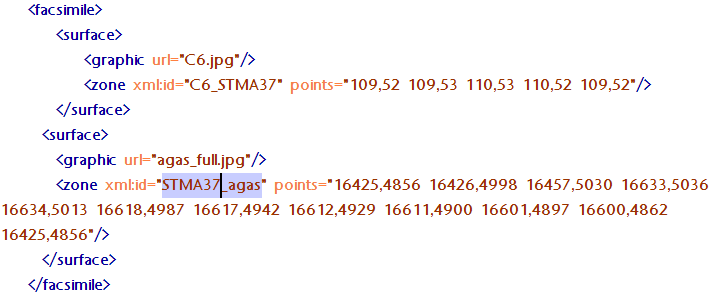
What if your shape is not perfect first time around? You can easily edit it after
it’s completed. Put your mouse over one of the existing points to click and move it;
put your mouse over one of the lines to add a new point. Every time you make a change
to the shape, the XML in the red box will update itself automatically.

If you need to delete one of the nodes in your shape, press the Shift key and click
on it.
It is best to have the map zoomed to its maximum size when you create the shape, because
you’ll be more accurate. If you’re outlining a large area, this may mean that the
shape does not completely fit on the screen. Don’t worry about this; even while you’re
in the middle of drawing the shape, you can still click and hold (hold down the mouse
button), drag the map around, and release without adding a new point in your shape.
It’s only when you click and release immediately that a new point is added.
¶Creating MultiLineStrings
While we usually draw buildings as shapes, streets are drawn
as MultiLineStrings (in other words, a series of connected lines). The process is
exactly the same as for Polygons, except that to finish the shape,
you just double-click on the last point. When tracing a street, start the line in
the middle of the junction where the street starts, and end in the middle of the junction
where it ends. Keep the line in the middle of the street.

¶Creating Points
Some locations cannot be precisely outlined, perhaps because
although we know approximately where they were, they do not
actually appear on the map. You can use a Point for this.
Creating a Point is the simplest process of all: select Point from the drop-down list, then click on the location.
¶Creating a MultiPolygon
There will be some circumstances in which you need to associate multiple polygons
with a single
location. For example, imagine that a guild owns two buildings which are not contiguous;
in one sense,
they are the same
location,but they are clearly two separate shapes on the map.
This can be done by creating multiple
<zone> elements inside the <surface>
element for the map. Here is an example:
<surface>
<graphic url="agas_full.jpg"/>
<zone xml:id="STBO4_1_agas" points="18913,6593 18919,6692 18983,6687 18994,6686 18995,6621 18995,6593 18913,6593"></zone>
<zone xml:id="STBO4_2_agas" points="18994,6681 18998,6708 19007,6721 19032,6721 19033,6682 18994,6681"></zone>
</surface>
Each <graphic url="agas_full.jpg"/>
<zone xml:id="STBO4_1_agas" points="18913,6593 18919,6692 18983,6687 18994,6686 18995,6621 18995,6593 18913,6593"></zone>
<zone xml:id="STBO4_2_agas" points="18994,6681 18998,6708 19007,6721 19032,6721 19033,6682 18994,6681"></zone>
</surface>
<zone> has a different @xml:id, created by adding an underscore followed by a digit after
the main location @xml:id. You will have to draw each of these shapes separately on the map, selecting
Polygon from the drop-down list; create the first one in the normal way, copying
the whole <surface> element into the location file, and then for each subsequent polygon, copy
only the <zone> element from the code box into the appropriate place as a sibling of the first one.
Note that you can only combine polygons in this way; you cannot create sets of MultiLineStrings
or Points.
¶Editing an Existing Location
Sometimes you will have to make changes to a location which has been entered by someone
else, and is already showing on the map. To do this, first zoom into the location
and select it:
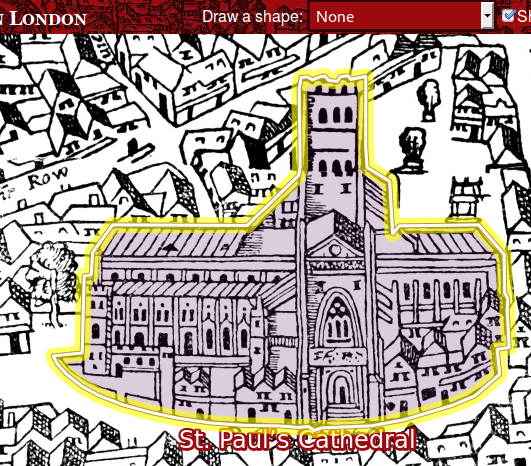
Then choose Clone selected feature from the drop-down list. The shape will turn into a red outline which you can edit
as explained above. As you edit, the XML in the red box will change, and when you’re
happy with the result, you can copy/paste the XML into the location
file, replacing the original
<surface> element. Ensure that you update the <respStmt> in the <teiHeader>, giving yourself credit as the Geographic Information Specialist.See
Create a MoEML <teiHeader> for details on how to encode a <respStmt>.
¶Bookmarking Shapes
Just as you can bookmark locations or sets of locations,
you can also bookmark a shape you have created. This can be handy if you’re emailing
someone and would like to refer
to a specific location on the map, if you would like to suggest a particular location
for inclusion, or if you would like to share a custom shape that does not belong in
the database.2 To do this, simply create the
shape as you normally would, and then when you’ve finished, press the Bookmark button. A long,
inscrutable URL will be created and a popup alert will tell you that it is about to
redirect you to the bookmarked URL.

Press OK and the page will redirect you to the bookmark URL. Once the page has reloaded,
you can copy and paste the entire URL in the address bar. If you plug this URL into
a browser, the map will recreate the shape and zoom to it,
also showing the TEI
<surface> element at the bottom of the screen.
¶Uncertainty and Imprecision
It is often the case that a feature may not appear on the Agas Map, although we know
more or less where it
should be if it did appear; or that we know more or less, but not exactly, where a
feature is. In order to be truthful,
we need to record the level of certainty and precision associated with a location.
The
<certainty> and <precision> elements enable us to do that. We use <certainty> to quantify
our confidence that the location assigned is the correct location; and we use <precision> to quantify how
accurateour point or outline is assumed to be. This is perhaps best explained through examples.
<zone xml:id="ROSE66_agas" points="14676,9076 14910,9081 14918,9405 14684,9401 14676,9076">
<precision precision="low" resp="mol:HOLM3"></precision>
<certainty cert="medium" resp="mol:HOLM3" locus="value"></certainty>
</zone>
<precision precision="low" resp="mol:HOLM3"></precision>
<certainty cert="medium" resp="mol:HOLM3" locus="value"></certainty>
</zone>
The
<precision> and <certainty> elements appear as children of the <zone> element to which
they refer. In the absence of these elements, certainty and precision are assumed
to be high. The @precision
and @cert attributes record the level of certainty or precision in each case;
allowed values are:
-
"high": default value -
"medium" -
"low" -
"unknown"3
@resp (using the standard "mol" prefix and your @xml:id)
to identify someone (usually yourself) as the person responsible for introducing or
encoding this expression of doubt. Where appropriate, you might also provide @source to point to one or more sources of evidence; the source can either be an internal
bibliographic item (and thus pointed to using the standard mol prefix and the @xml:id of the bibliographic item) or an external URI.
The method outlined above is relatively crude; it allows us to say that the feature
may not in fact be at the location
specified (
<certainty>) and/or that the coordinates provided may be somewhat inaccurate (<precision>).
You may wish to add
a <note> inside the <zone> to clarify the situation for a human reader, and it is also possible to provide
much more specificity in the encoding if we determine that this is desirable. If the
location consists of more than one zone, add a <note> inside <surface>.
Note also that using this method, it is possible to encode multiple possible locations
for a single feature, each with
its own level of certainty; you might believe that it is most likely in one place
(
@cert="medium") but that
it could possibly be somewhere else (@cert="low"), and each location can have its own <zone>
element containing a <certainty> element, with @source pointing to the evidence available.
<facsimile>
<surface>
<note type="editorial" resp="mol:JENS1">The southern half of the alley, if it existed, would have been destroyed for the building of the Royal Exchange. The northern half ran east of St. Christopher le Stocks. Neither half is visible on the 1633 version of the Agas Map.</note>
<graphic url="agas_full.jpg"/>
<zone cert="medium" xml:id="CHRI4_1_agas" ulx="16783" uly="4684" lrx="16883" lry="4817"></zone>
<zone cert="low" xml:id="CHRI4_2_agas" ulx="16687" uly="4562" lrx="16749" lry="4656"></zone>
</surface>
</facsimile>
<surface>
<note type="editorial" resp="mol:JENS1">The southern half of the alley, if it existed, would have been destroyed for the building of the Royal Exchange. The northern half ran east of St. Christopher le Stocks. Neither half is visible on the 1633 version of the Agas Map.</note>
<graphic url="agas_full.jpg"/>
<zone cert="medium" xml:id="CHRI4_1_agas" ulx="16783" uly="4684" lrx="16883" lry="4817"></zone>
<zone cert="low" xml:id="CHRI4_2_agas" ulx="16687" uly="4562" lrx="16749" lry="4656"></zone>
</surface>
</facsimile>
Notes
- The OpenLayers implementation of the Agas map was first created in 2014, replacing
the old
star map.
↑ - See, for instance, the footnote in Silver Street, which shows the house that Shakespeare may have lived in during his stay on Silver Street.↑
- Note that you will almost always encode certainty and precision using
"high","medium", or"low"; there are few instances where"unknown"is useful.↑
Cite this page
MLA citation
Add MoEML Locations to the Agas Map.The Map of Early Modern London, edited by , U of Victoria, 15 Sep. 2020, mapoflondon.uvic.ca/agas_locations.htm.
Chicago citation
Add MoEML Locations to the Agas Map.The Map of Early Modern London. Ed. . Victoria: University of Victoria. Accessed September 15, 2020. https://mapoflondon.uvic.ca/agas_locations.htm.
APA citation
2020. Add MoEML Locations to the Agas Map. In (Ed), The Map of Early Modern London. Victoria: University of Victoria. Retrieved from https://mapoflondon.uvic.ca/agas_locations.htm.
RIS file (for RefMan, EndNote etc.)
Provider: University of Victoria Database: The Map of Early Modern London Content: text/plain; charset="utf-8" TY - ELEC A1 - Holmes, Martin ED - Jenstad, Janelle T1 - Add MoEML Locations to the Agas Map T2 - The Map of Early Modern London PY - 2020 DA - 2020/09/15 CY - Victoria PB - University of Victoria LA - English UR - https://mapoflondon.uvic.ca/agas_locations.htm UR - https://mapoflondon.uvic.ca/xml/standalone/agas_locations.xml ER -
RefWorks
RT Web Page SR Electronic(1) A1 Holmes, Martin A6 Jenstad, Janelle T1 Add MoEML Locations to the Agas Map T2 The Map of Early Modern London WP 2020 FD 2020/09/15 RD 2020/09/15 PP Victoria PB University of Victoria LA English OL English LK https://mapoflondon.uvic.ca/agas_locations.htm
TEI citation
<bibl type="mla"><author><name ref="#HOLM3"><surname>Holmes</surname>, <forename>Martin</forename>
<forename>D.</forename></name></author> <title level="a">Add MoEML Locations to the
Agas Map</title>. <title level="m">The Map of Early Modern London</title>, edited
by <editor><name ref="#JENS1"><forename>Janelle</forename> <surname>Jenstad</surname></name></editor>,
<publisher>U of Victoria</publisher>, <date when="2020-09-15">15 Sep. 2020</date>,
<ref target="https://mapoflondon.uvic.ca/agas_locations.htm">mapoflondon.uvic.ca/agas_locations.htm</ref>.</bibl>
Personography
-
Joey Takeda
JT
Programmer, 2018-present. Junior Programmer, 2015-2017. Research Assistant, 2014-2017. Joey Takeda was a graduate student at the University of British Columbia in the Department of English (Science and Technology research stream). He completed his BA honours in English (with a minor in Women’s Studies) at the University of Victoria in 2016. His primary research interests included diasporic and indigenous Canadian and American literature, critical theory, cultural studies, and the digital humanities.Roles played in the project
-
Abstract Author
-
Author
-
Author of Abstract
-
Author of Introduction
-
Author of Stub
-
CSS Editor
-
Compiler
-
Conceptor
-
Copy Editor
-
Copy Editor and Revisor
-
Data Manager
-
Date Encoder
-
Editor
-
Encoder
-
Encoder (Bibliography)
-
Geographic Information Specialist
-
Geographic Information Specialist (Agas)
-
Junior Programmer
-
Markup Editor
-
Metadata Co-Architect
-
MoEML Encoder
-
MoEML Transcriber
-
Post-conversion processing and markup correction
-
Programmer
-
Proofreader
-
Researcher
-
Second Author
-
Toponymist
-
Transcriber
-
Transcription Editor
Contributions by this author
Joey Takeda is a member of the following organizations and/or groups:
Joey Takeda is mentioned in the following documents:
-
-
Tye Landels-Gruenewald
TLG
Data Manager, 2015-2016. Research Assistant, 2013-2015. Tye completed his undergraduate honours degree in English at the University of Victoria in 2015.Roles played in the project
-
Author
-
Author of Term Descriptions
-
CSS Editor
-
Compiler
-
Conceptor
-
Copy Editor
-
Data Manager
-
Editor
-
Encoder
-
Geographic Information Specialist
-
Markup Editor
-
Metadata Architect
-
MoEML Researcher
-
Name Encoder
-
Proofreader
-
Researcher
-
Toponymist
-
Transcriber
Contributions by this author
Tye Landels-Gruenewald is a member of the following organizations and/or groups:
Tye Landels-Gruenewald is mentioned in the following documents:
-
-
Kim McLean-Fiander
KMF
Director of Pedagogy and Outreach, 2015–present. Associate Project Director, 2015–present. Assistant Project Director, 2013-2014. MoEML Research Fellow, 2013. Kim McLean-Fiander comes to The Map of Early Modern London from the Cultures of Knowledge digital humanities project at the University of Oxford, where she was the editor of Early Modern Letters Online, an open-access union catalogue and editorial interface for correspondence from the sixteenth to eighteenth centuries. She is currently Co-Director of a sister project to EMLO called Women’s Early Modern Letters Online (WEMLO). In the past, she held an internship with the curator of manuscripts at the Folger Shakespeare Library, completed a doctorate at Oxford on paratext and early modern women writers, and worked a number of years for the Bodleian Libraries and as a freelance editor. She has a passion for rare books and manuscripts as social and material artifacts, and is interested in the development of digital resources that will improve access to these materials while ensuring their ongoing preservation and conservation. An avid traveler, Kim has always loved both London and maps, and so is particularly delighted to be able to bring her early modern scholarly expertise to bear on the MoEML project.Roles played in the project
-
Associate Project Director
-
Author
-
Author of MoEML Introduction
-
CSS Editor
-
Compiler
-
Contributor
-
Copy Editor
-
Data Contributor
-
Data Manager
-
Director of Pedagogy and Outreach
-
Editor
-
Encoder
-
Encoder (People)
-
Geographic Information Specialist
-
JCURA Co-Supervisor
-
Managing Editor
-
Markup Editor
-
Metadata Architect
-
Metadata Co-Architect
-
MoEML Research Fellow
-
MoEML Transcriber
-
Proofreader
-
Second Author
-
Secondary Author
-
Secondary Editor
-
Toponymist
-
Vetter
Contributions by this author
Kim McLean-Fiander is a member of the following organizations and/or groups:
Kim McLean-Fiander is mentioned in the following documents:
-
-
Janelle Jenstad
JJ
Janelle Jenstad is Associate Professor of English at the University of Victoria, Director of The Map of Early Modern London, and PI of Linked Early Modern Drama Online. She has taught at Queen’s University, the Summer Academy at the Stratford Festival, the University of Windsor, and the University of Victoria. With Jennifer Roberts-Smith and Mark Kaethler, she co-edited Shakespeare’s Language in Digital Media (Routledge). She has prepared a documentary edition of John Stow’s A Survey of London (1598 text) for MoEML and is currently editing The Merchant of Venice (with Stephen Wittek) and Heywood’s 2 If You Know Not Me You Know Nobody for DRE. Her articles have appeared in Digital Humanities Quarterly, Renaissance and Reformation,Journal of Medieval and Early Modern Studies, Early Modern Literary Studies, Elizabethan Theatre, Shakespeare Bulletin: A Journal of Performance Criticism, and The Silver Society Journal. Her book chapters have appeared (or will appear) in Institutional Culture in Early Modern Society (Brill, 2004), Shakespeare, Language and the Stage, The Fifth Wall: Approaches to Shakespeare from Criticism, Performance and Theatre Studies (Arden/Thomson Learning, 2005), Approaches to Teaching Othello (Modern Language Association, 2005), Performing Maternity in Early Modern England (Ashgate, 2007), New Directions in the Geohumanities: Art, Text, and History at the Edge of Place (Routledge, 2011), Early Modern Studies and the Digital Turn (Iter, 2016), Teaching Early Modern English Literature from the Archives (MLA, 2015), Placing Names: Enriching and Integrating Gazetteers (Indiana, 2016), Making Things and Drawing Boundaries (Minnesota, 2017), and Rethinking Shakespeare’s Source Study: Audiences, Authors, and Digital Technologies (Routledge, 2018).Roles played in the project
-
Annotator
-
Author
-
Author of Abstract
-
Author of Stub
-
Author of Term Descriptions
-
Author of Textual Introduction
-
Compiler
-
Conceptor
-
Copy Editor
-
Copyeditor
-
Course Instructor
-
Course Supervisor
-
Course supervisor
-
Data Manager
-
Editor
-
Encoder
-
Encoder (Structure and Toponyms)
-
Final Markup Editor
-
GIS Specialist
-
Geographic Information Specialist
-
Geographic Information Specialist (Modern)
-
Geographical Information Specialist
-
JCURA Co-Supervisor
-
Main Transcriber
-
Markup Editor
-
Metadata Co-Architect
-
MoEML Project Director
-
MoEML Transcriber
-
Name Encoder
-
Peer Reviewer
-
Primary Author
-
Project Director
-
Proofreader
-
Researcher
-
Reviewer
-
Reviser
-
Revising Author
-
Second Author
-
Second Encoder
-
Toponymist
-
Transcriber
-
Transcription Proofreader
-
Vetter
Contributions by this author
Janelle Jenstad is a member of the following organizations and/or groups:
Janelle Jenstad is mentioned in the following documents:
Janelle Jenstad authored or edited the following items in MoEML’s bibliography:
-
Jenstad, Janelle.
Building a Gazetteer for Early Modern London, 1550-1650.
Placing Names. Ed. Merrick Lex Berman, Ruth Mostern, and Humphrey Southall. Bloomington and Indianapolis: Indiana UP, 2016. 129-145. -
Jenstad, Janelle.
The Burse and the Merchant’s Purse: Coin, Credit, and the Nation in Heywood’s 2 If You Know Not Me You Know Nobody.
The Elizabethan Theatre XV. Ed. C.E. McGee and A.L. Magnusson. Toronto: P.D. Meany, 2002. 181–202. Print. -
Jenstad, Janelle.
Early Modern Literary Studies 8.2 (2002): 5.1–26..The City Cannot Hold You
: Social Conversion in the Goldsmith’s Shop. -
Jenstad, Janelle.
The Silver Society Journal 10 (1998): 40–43.The Gouldesmythes Storehowse
: Early Evidence for Specialisation. -
Jenstad, Janelle.
Lying-in Like a Countess: The Lisle Letters, the Cecil Family, and A Chaste Maid in Cheapside.
Journal of Medieval and Early Modern Studies 34 (2004): 373–403. doi:10.1215/10829636–34–2–373. -
Jenstad, Janelle.
Public Glory, Private Gilt: The Goldsmiths’ Company and the Spectacle of Punishment.
Institutional Culture in Early Modern Society. Ed. Anne Goldgar and Robert Frost. Leiden: Brill, 2004. 191–217. Print. -
Jenstad, Janelle.
Smock Secrets: Birth and Women’s Mysteries on the Early Modern Stage.
Performing Maternity in Early Modern England. Ed. Katherine Moncrief and Kathryn McPherson. Aldershot: Ashgate, 2007. 87–99. Print. -
Jenstad, Janelle.
Using Early Modern Maps in Literary Studies: Views and Caveats from London.
GeoHumanities: Art, History, Text at the Edge of Place. Ed. Michael Dear, James Ketchum, Sarah Luria, and Doug Richardson. London: Routledge, 2011. Print. -
Jenstad, Janelle.
Versioning John Stow’s A Survey of London, or, What’s New in 1618 and 1633?.
Janelle Jenstad Blog. https://janellejenstad.com/2013/03/20/versioning-john-stows-a-survey-of-london-or-whats-new-in-1618-and-1633/. -
Shakespeare, William. The Merchant of Venice. Ed. Janelle Jenstad. Internet Shakespeare Editions. Open.
-
Stow, John. A SVRVAY OF LONDON. Contayning the Originall, Antiquity, Increase, Moderne estate, and description of that Citie, written in the yeare 1598. by Iohn Stow Citizen of London. Also an Apologie (or defence) against the opinion of some men, concerning that Citie, the greatnesse thereof. With an Appendix, containing in Latine, Libellum de situ & nobilitate Londini: written by William Fitzstephen, in the raigne of Henry the second. Ed. Janelle Jenstad and the MoEML Team. MoEML. Transcribed. Web.
-
-
Martin D. Holmes
MDH
Programmer at the University of Victoria Humanities Computing and Media Centre (HCMC). Martin ported the MOL project from its original PHP incarnation to a pure eXist database implementation in the fall of 2011. Since then, he has been lead programmer on the project and has also been responsible for maintaining the project schemas. He was a co-applicant on MoEML’s 2012 SSHRC Insight Grant.Roles played in the project
-
Abstract Author
-
Author
-
Author of abstract
-
Conceptor
-
Editor
-
Encoder
-
Markup editor
-
Name Encoder
-
Post-conversion and Markup Editor
-
Post-conversion processing and markup correction
-
Programmer
-
Proofreader
-
Researcher
Contributions by this author
Martin D. Holmes is a member of the following organizations and/or groups:
Martin D. Holmes is mentioned in the following documents:
-
Locations
-
St. Mary Woolchurch is mentioned in the following documents:
-
Silver Street
Silver Street was a small but historically significant street that ran east-west, emerging out of Noble Street in the west and merging into Addle Street in the east. Monkwell Street (labelledMuggle St.
on the Agas map) lay to the north of Silver Street and seems to have marked its westernmost point, and Little Wood Street, also to the north, marked its easternmost point. Silver Street ran through Cripplegate Ward and Farringdon Ward Within. It is labelled asSyluer Str.
on the Agas map and is drawn correctly. Perhaps the most noteworthy historical fact about Silver Street is that it was the location of one of the houses in which William Shakespeare dwelled during his time in London.Silver Street is mentioned in the following documents:

